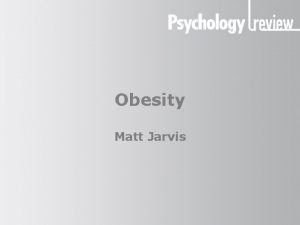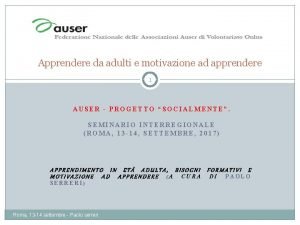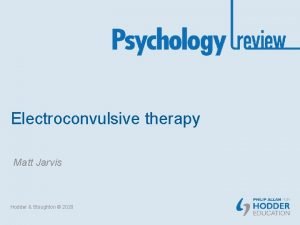www hoddereducation co ukpsychologyreview Mindfulness Matt Jarvis Hodder







- Slides: 7

www. hoddereducation. co. uk/psychologyreview Mindfulness Matt Jarvis Hodder & Stoughton © 2017

Defining mindfulness Literal definition: To be aware of something Contextual definition: ‘Paying attention in a particular way: on purpose, in the present moment, and non-judgmentally. ’ (Kabat-Zinn 1994). Hodder & Stoughton © 2017

Historical roots • Mindfulness has its roots in the Buddhist tradition • The idea is around 2, 500 years old As this graph shows, mindfulness is making a huge comeback in psychology. Hodder & Stoughton © 2017

Mindfulness in clinical practice A range of therapeutic applications have been developed in health and clinical psychology. Mindfulness-based stress reduction Mindfulness-based cognitive therapy Used to treat chronic pain Used to treat depression Hodder & Stoughton © 2017

Mindfulness in other settings Mindfulness has been used in a variety of non-clinical settings to improve mood and mental health. • Many large companies like Google use mindfulness to aid wellbeing in the workplace. • There is some evidence to support these non-clinical uses of mindfulness but this is inconsistent in quality and findings. • Some schools are trialling the use of mindfulness to improve student wellbeing. Hodder & Stoughton © 2017

Evaluation of the mindfulness concept For… • Clinical trials suggest mindfulness-based therapies are effective for pain and depression. • 88% of published trials have found positive results. Against… • The evidence for mindfulness techniques is generally less strong in nonclinical contexts. • There is a suggestion that employers employ mindfulness techniques instead of tackling the causes of stress at work. • There may be a problem of publication bias in studies of mindfulness. Hodder & Stoughton © 2017

Conclusions • Despite being an ancient set of techniques, mindfulness has been incorporated successfully into contemporary clinical practice. • In clinical settings mindfulness has been used successfully to treat stress, pain and depression. • In non-clinical settings the evidence base is less strong and there are suggestions of publication bias and unethical business practices. Hodder & Stoughton © 2017













